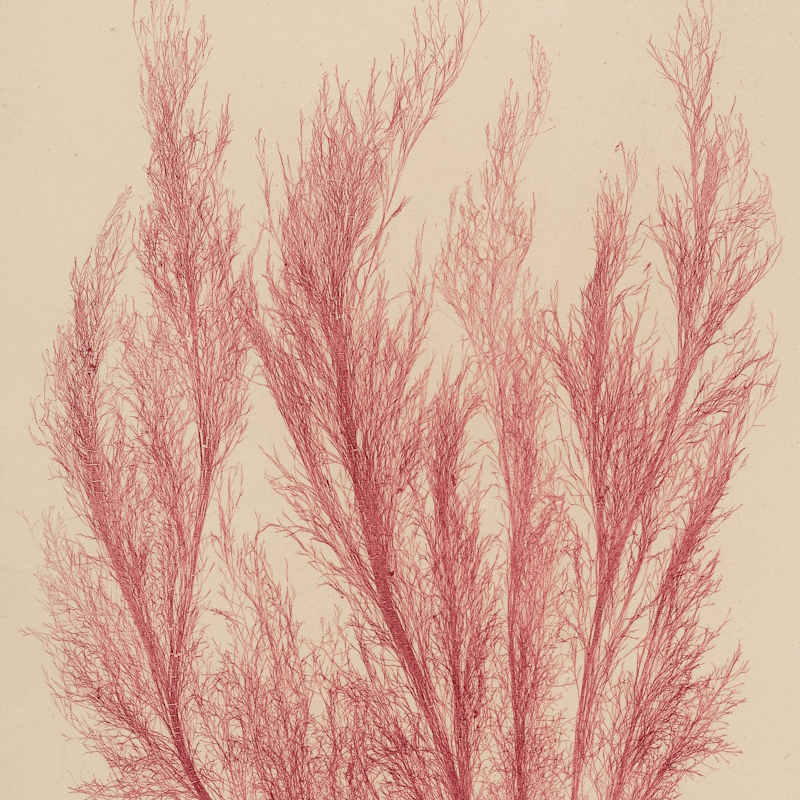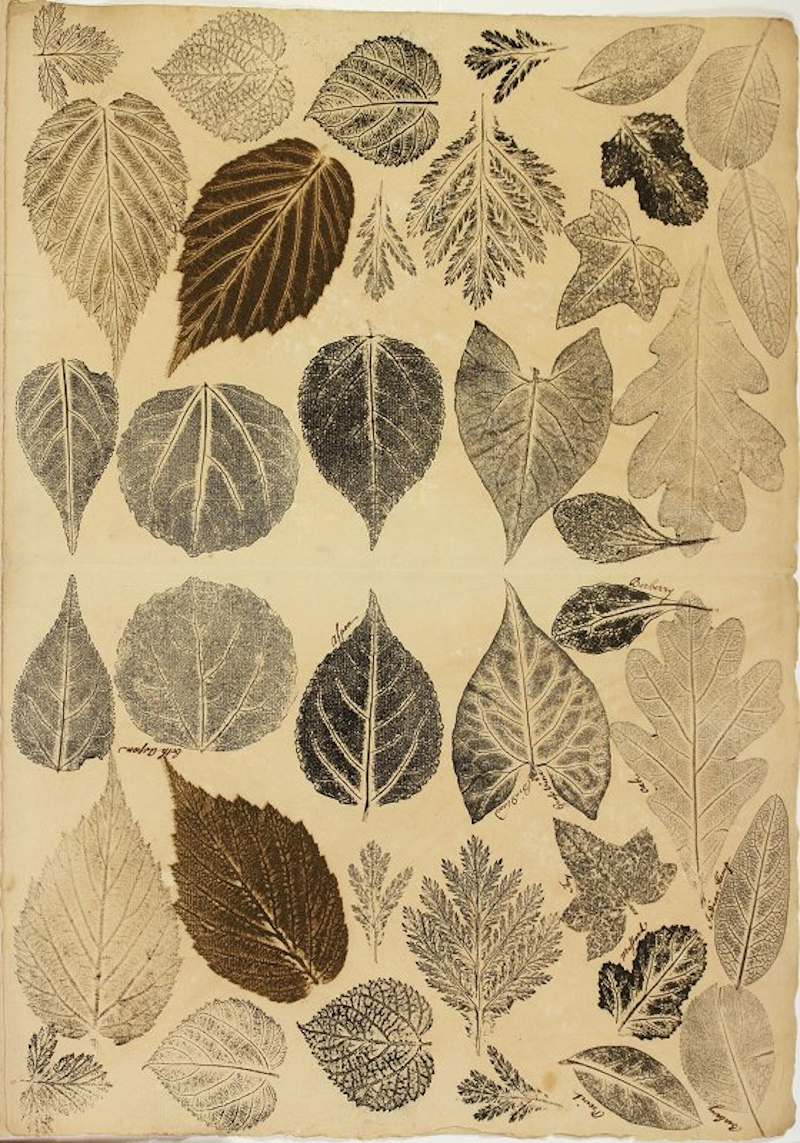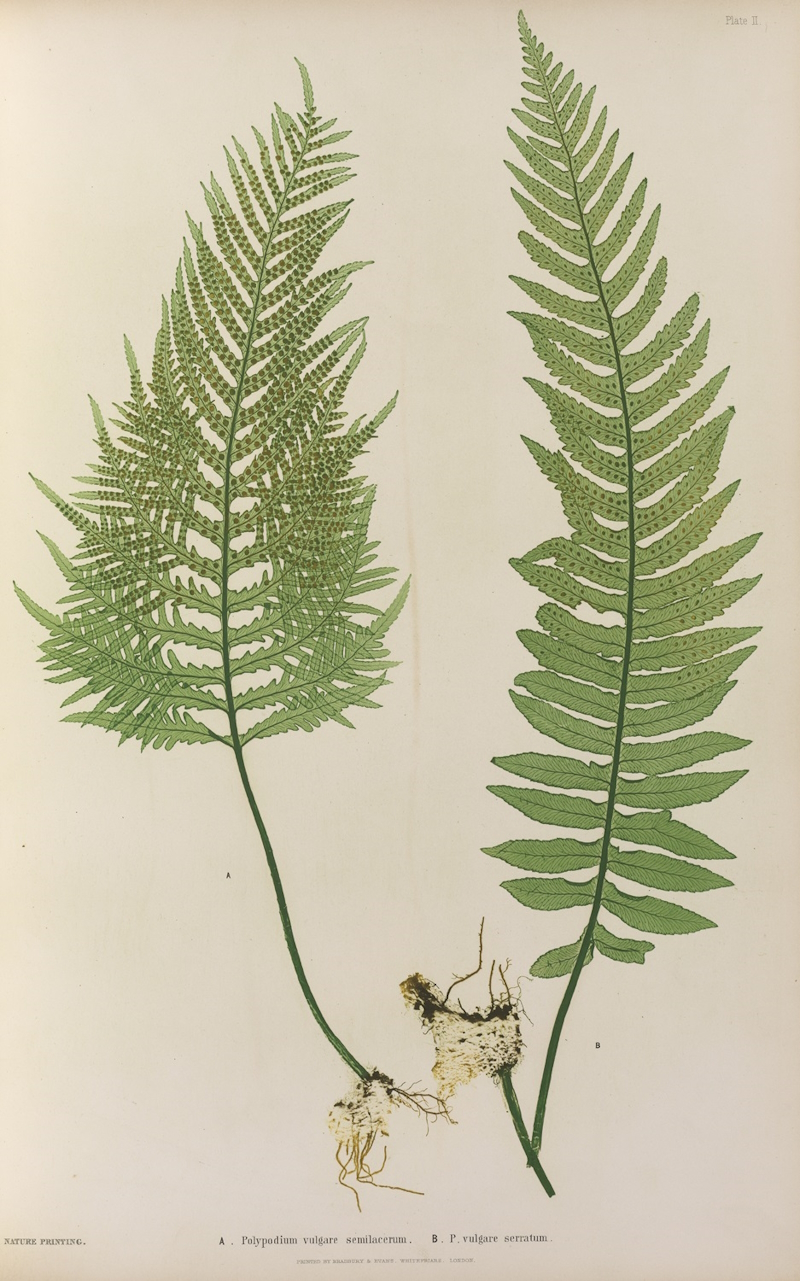Katherine Marshall traces the development of nature printing within the history of scientific illustration.

I’ve been trying a spot of amateur printmaking recently. In my first experiments, I pressed dried leaves into soft ground (wax) – the impressions exposed the zinc plate below, which I then etched in acid and printed in the intaglio fashion.
What I had created in essence was a nature print, and this led me to investigate how this method of contact reproduction had been practised in the history of scientific illustration. In its simplest form a nature print is created by the direct inking and printing of specimens. An early example in the collections of the Royal Society is the impression of two oak leaves by microscopist and naturalist Antoni van Leeuwenhoek FRS, who created an accurate illustration of the leaf which he then marked to show the parts he had observed under his lens:
 Nature print of oak leaves, from a letter by Antoni van Leeuwenhoek to Henry Oldenburg, dated at Delft, 26 March 1675 (RS.15713)
Nature print of oak leaves, from a letter by Antoni van Leeuwenhoek to Henry Oldenburg, dated at Delft, 26 March 1675 (RS.15713)
Leeuwenhoek’s print shows two leaves of the oak tree, similar in shape but distinctly different in their details. The unique nature of individual leaves was noted by the polymath and statesman Benjamin Franklin FRS, who used this method of printing to prevent counterfeiting in the development of paper money.
Franklin began creating new paper money for the American colonies soon after he opened his printing house in 1728. A recent study by the University of Notre Dame has revealed some of the techniques he employed in the creation of the bills to deter copying: unusual printing inks, spelling mistakes and the inclusion of a nature print on the back of the note. Leaves and sometimes groups of leaves were cast in lead, and the resulting print would have been difficult for forgers to reproduce – assuming they weren’t already dissuaded by the inscription ‘To Counterfeit is DEATH’! Here's an example of a five pound note from 1760.
Franklin was likely influenced by his friend and collaborator Joseph Breintnall. An amateur naturalist, Breintnall experimented with nature printing in his attempts to catalogue the plants of Philadelphia. He would ink both sides of the leaf and then sandwich it inside a folded sheet of paper, a butterfly technique allowing both sides of the specimen to be rendered in the same print.
Breintnall is thus credited with the first application of nature printing as a scientific tool. He sent his prints to English naturalists such as Peter Collinson FRS, to satisfy their growing curiosity for the natural history of America. Sadly, none seem to have been retained in the collections of the Royal Society, despite Collinson being an advocate for Breintnall’s work in the Philosophical Transactions.
 Nature prints of leaves by Joseph Breintnall, ca. 1731-1744. Credit: Library Company of Philadelphia
Nature prints of leaves by Joseph Breintnall, ca. 1731-1744. Credit: Library Company of Philadelphia
The technique of nature printing was later developed by Austrian printer Alois Auer in the early nineteenth century, with the aim of producing scientifically accurate books of natural history. Using electrotyping, a recently-invented technology, Auer was able to create a copper plate from lead moulds, resulting in a more robust plate for longer print runs and with much finer results, copper being the favoured metal for high-quality engravings.
The method was picked up by Henry Bradbury while studying under Auer at the imperial printing office in Vienna. Bradbury refined the technique and lectured on his new method at the Royal Institution, leading to a public dispute with Auer over scientific priority. Interestingly, Bradbury also turned his attention to the security and manufacture of bank notes, in another lecture delivered at the Royal Institution. However, he doesn’t seem to have mentioned Benjamin Franklin’s technique of using nature printing to deter counterfeiters.
Despite his success in creating accurate copies of specimens, Bradbury committed suicide at the age of 30, leaving only two nature-printed works produced during his lifetime. The first was The ferns of Great Britain and Ireland (1855) by Thomas Moore, edited by John Lindley FRS, the flat fronds of the ferns lending themselves perfectly to the technique of contact printing:
 Nature-printed study of the terrestrial fern Polypodium vulgare. Plate II to The ferns of Great Britain and Ireland by Thomas Moore, edited by John Lindley, nature printed by Henry Bradbury (1855)
Nature-printed study of the terrestrial fern Polypodium vulgare. Plate II to The ferns of Great Britain and Ireland by Thomas Moore, edited by John Lindley, nature printed by Henry Bradbury (1855)
Bradbury’s second work, The nature-printed British sea-weeds (1859), is reminiscent of the work of Anna Atkins and her early photographic technique of blueprinting. The authors, William Johnstone and Alexander Croall, paid poetic tribute to the cutting-edge technique in their foreword:
‘The Sea-weeds of Britain … are herein reproduced with all fidelity to structure, character and tint of the originals. The most crystalline water could scarcely more delicately float these lace-like trophies of the Garden of the Sea than do their pages.’
 Nature-printed study of the marine algae Polysiphonia stricta, here styled Polysiphonia urceolata. Plate XI from The nature-printed British sea-weeds by William Johnstone and Alexander Croall, nature-printed by Henry Bradbury. Volume 1. Rhodospermeae (1859) (RS.21505)
Nature-printed study of the marine algae Polysiphonia stricta, here styled Polysiphonia urceolata. Plate XI from The nature-printed British sea-weeds by William Johnstone and Alexander Croall, nature-printed by Henry Bradbury. Volume 1. Rhodospermeae (1859) (RS.21505)






